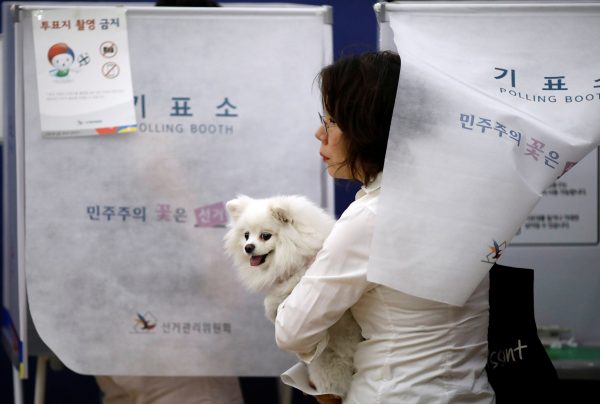since the country’s democratisation in 1987.
With Park’s impeachment and presidential candidates stomping for change on the campaign trail, constitutional reforms are again a hot topic.
The changes most frequently discussed are extending the current five-year, one-term presidential tenure to two four-year terms, and changing the presidential system to a semi-presidential or parliamentary system.
The one term presidency enacted in the 1987 constitution was a prophylactic against presidents building up power. Following World War II, South Korea experienced long periods of autocratic authority in the hands of executives who enjoyed concentrated power and few checks, interspersed with brief intervals of democratic government.
The single-term limit is meant to counteract the possibility of the ‘imperial president’ in South Korea — the president who successfully overrides the checks and balances of the other branches of government. With the term restriction, the ability of the president to command loyalties beyond their time in office is limited. Studies show that legislators are more willing to challenge the president’s policy agenda when faced with a term-limited president in the final term. This helps constrain the president’s ability to commandeer power.
Of course, term limits are no panacea. They induce the ‘lame duck’ effect, where the end of a presidential term removes incentives for legislators to back the president’s agenda.
That problem may be magnified in South Korea, where presidents generally enter office with high approval ratings but suffer low ratings by the middle of their term, usually caused by scandals, so that they typically limp out of office by the end of their term. And ‘lame duck’ presidents have motivation to resist legislative efforts that may thwart their agenda. These conditions set up perverse incentives that lead to gridlock and conflict rather than cooperation.
This may explain why constitutional reform debates re-emerge towards the end of presidential terms in South Korea. But are constitutional reforms likely to be adopted this time around?
There is certainly appetite for change. Public protests against president Park in the last months of 2016 swelled to 2 million people at times and exceeded even the pro-democracy demonstrations that ushered in the liberalisation of the autocratic political system in 1987.
The legislature voted 234 to 56 to impeach (with two abstentions and seven invalid votes) on 9 December 2016, well exceeding the two-thirds needed. This reflects the broad disapproval of Park, whose tenure raised concerns of insufficient consultation, influence peddling, bribery, corruption and abuse of power.
But it would be a mistake to single out Park for these problems. Every president in South Korea since democratisation has generally entered office with high approval ratings but left office deeply unpopular and under a cloud of scandal.
This discouraging trend is why constitutional reform is discussed so often. But this time around, three parties are pushing for reform. Indeed, in October 2016 president Park herself proposed constitutional revisions to be enacted at the end of her term. Of course, even then many considered her proposal disingenuous and intended to divert the growing tide of public protests.
The three parties are calling constitutional reforms in 2018 that will change the next presidential term to three years so that the schedule of all following presidential and legislative elections will coincide. That may pave the way for more cooperation between the president and the legislature. The proposal also revises the presidential term to two consecutive terms. If approved, the president elected following the change will serve a shortened term.
There was considerable resistance to an earlier proposal for a referendum to be held on 9 May, presidential election day. The largest party in the legislature, the opposition Minjoo (Democratic) Party, and the smaller Justice Party were against such a sudden change, as were the presidential front-runners, Moon Jae-in and Ahn Cheol-soo. Both Moon and Ahn have said that they are open to discussions to develop constitutional reforms further. Indeed, while Ahn’s opposition to the earlier proposal puts him at odds with his party, his current stance — to support constitutional reforms in 2018, so that the presidential and legislative terms will coincide in 2020 — puts him in step with the reformist agenda.
Resistance from the legislative parties and the two leading presidential candidates has deferred proposed constitutional reforms for now. But if the cycle of presidential politics in South Korea is any indication, it will not be the last time constitutional reform is discussed.
O. Fiona Yap is Associate Professor at the Crawford School of Public Policy, The Australian National University.


Both this analysis and the one by Mr. Pope fail to note the real source of corruption in S Korea: the excessive influence that the chaebol have on the political processes in the government. Unless these dynamics can be at least contained, if not eliminated, the kinds of reforms described in this piece and the one by Mr. Pope will have a marginal effect, at best.
Thank you for sharing your insight. Few will disagree with the chaebols’ contribution to corruption in Korea. That is the demand side of the corruption equation, with politicians providing the supply side. Efforts to curb this supply aspect — and these are significant signature efforts, such as the real name transactions pursued by President Kim Young-sam — meet with few success. That may be unsurprising: after all, the hallmarks of corruption are secrecy and the lack of direct, complaining victims. The lack of success on curbing the demand side partly explains efforts to tackle the supply side, through institutional and constitutional reforms.
In order for the dates of all next presidential and parliamentary elections to match, the three parties are advocating for constitutional revisions in 2018 that will increase the length of the next president’s tenure to three years. This could make it easier for the president and the legislature to work together more frequently. The plan also changes the length of the presidential term to two successive terms. The president who is elected after the reform is adopted will have a shorter term.